《数据库系统概念 Database System Concepts》原书教学资源(第六版,PPT课件讲稿,英文版)Chapter 21 Information Retrieval
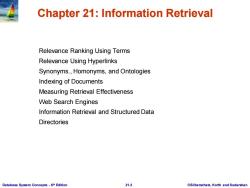
Chapter 21:Information Retrieval Relevance Ranking Using Terms Relevance Using Hyperlinks Synonyms.,Homonyms,and Ontologies Indexing of Documents Measuring Retrieval Effectiveness Web Search Engines Information Retrieval and Structured Data Directories Database System Concepts-6th Edition 21.2 @Silberschatz,Korth and Sudarshan
Database System Concepts - 6 21.2 ©Silberschatz, Korth and Sudarshan th Edition Chapter 21: Information Retrieval Relevance Ranking Using Terms Relevance Using Hyperlinks Synonyms., Homonyms, and Ontologies Indexing of Documents Measuring Retrieval Effectiveness Web Search Engines Information Retrieval and Structured Data Directories
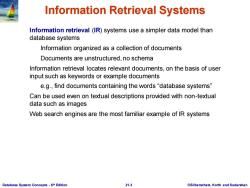
Information Retrieval Systems Information retrieval(IR)systems use a simpler data model than database systems Information organized as a collection of documents Documents are unstructured,no schema Information retrieval locates relevant documents,on the basis of user input such as keywords or example documents e.g.,find documents containing the words "database systems" Can be used even on textual descriptions provided with non-textual data such as images Web search engines are the most familiar example of IR systems Database System Concepts-6th Edition 21.3 @Silberschatz,Korth and Sudarshan
Database System Concepts - 6 21.3 ©Silberschatz, Korth and Sudarshan th Edition Information Retrieval Systems Information retrieval (IR) systems use a simpler data model than database systems Information organized as a collection of documents Documents are unstructured, no schema Information retrieval locates relevant documents, on the basis of user input such as keywords or example documents e.g., find documents containing the words “database systems” Can be used even on textual descriptions provided with non-textual data such as images Web search engines are the most familiar example of IR systems
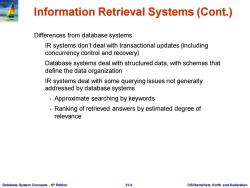
Information Retrieval Systems(Cont.) Differences from database systems IR systems don't deal with transactional updates(including concurrency control and recovery) Database systems deal with structured data,with schemas that define the data organization IR systems deal with some querying issues not generally addressed by database systems Approximate searching by keywords Ranking of retrieved answers by estimated degree of relevance Database System Concepts-6th Edition 21.4 @Silberschatz,Korth and Sudarshan
Database System Concepts - 6 21.4 ©Silberschatz, Korth and Sudarshan th Edition Information Retrieval Systems (Cont.) Differences from database systems IR systems don’t deal with transactional updates (including concurrency control and recovery) Database systems deal with structured data, with schemas that define the data organization IR systems deal with some querying issues not generally addressed by database systems Approximate searching by keywords Ranking of retrieved answers by estimated degree of relevance
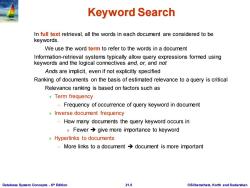
Keyword Search In full text retrieval,all the words in each document are considered to be keywords. We use the word term to refer to the words in a document Information-retrieval systems typically allow query expressions formed using keywords and the logical connectives and,or,and not Ands are implicit,even if not explicitly specified Ranking of documents on the basis of estimated relevance to a query is critical Relevance ranking is based on factors such as Term frequency -Frequency of occurrence of query keyword in document Inverse document frequency How many documents the query keyword occurs in 》Fewer→give more importance to keyword Hyperlinks to documents -More links to a document>document is more important Database System Concepts-6th Edition 21.5 @Silberschatz,Korth and Sudarshan
Database System Concepts - 6 21.5 ©Silberschatz, Korth and Sudarshan th Edition Keyword Search In full text retrieval, all the words in each document are considered to be keywords. We use the word term to refer to the words in a document Information-retrieval systems typically allow query expressions formed using keywords and the logical connectives and, or, and not Ands are implicit, even if not explicitly specified Ranking of documents on the basis of estimated relevance to a query is critical Relevance ranking is based on factors such as Term frequency – Frequency of occurrence of query keyword in document Inverse document frequency – How many documents the query keyword occurs in » Fewer ➔ give more importance to keyword Hyperlinks to documents – More links to a document ➔ document is more important
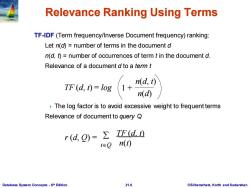
Relevance Ranking Using Terms TF-IDF(Term frequency/Inverse Document frequency)ranking: Let n(d)=number of terms in the document d n(d,t)=number of occurrences of term t in the document d. Relevance of a document d to a term t n(d,t) TF (d,t)=log The log factor is to avoid excessive weight to frequent terms Relevance of document to query Q r(d,9)=∑ TF(d.t) tEO n(t) Database System Concepts-6th Edition 21.6 @Silberschatz,Korth and Sudarshan
Database System Concepts - 6 21.6 ©Silberschatz, Korth and Sudarshan th Edition Relevance Ranking Using Terms TF-IDF (Term frequency/Inverse Document frequency) ranking: Let n(d) = number of terms in the document d n(d, t) = number of occurrences of term t in the document d. Relevance of a document d to a term t The log factor is to avoid excessive weight to frequent terms Relevance of document to query Q n(d) n(d, t) TF (d, t) = log 1 + r (d, Q) = TF (d, t) tQ n(t)
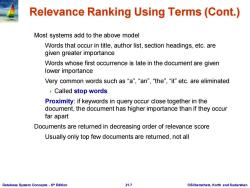
Relevance Ranking Using Terms(Cont.) Most systems add to the above model Words that occur in title,author list,section headings,etc.are given greater importance Words whose first occurrence is late in the document are given lower importance Very common words such as“a",“an",“the",“it"etc.are eliminated Called stop words Proximity:if keywords in query occur close together in the document,the document has higher importance than if they occur far apart Documents are returned in decreasing order of relevance score Usually only top few documents are returned,not all Database System Concepts-6th Edition 21.7 @Silberschatz,Korth and Sudarshan
Database System Concepts - 6 21.7 ©Silberschatz, Korth and Sudarshan th Edition Relevance Ranking Using Terms (Cont.) Most systems add to the above model Words that occur in title, author list, section headings, etc. are given greater importance Words whose first occurrence is late in the document are given lower importance Very common words such as “a”, “an”, “the”, “it” etc. are eliminated Called stop words Proximity: if keywords in query occur close together in the document, the document has higher importance than if they occur far apart Documents are returned in decreasing order of relevance score Usually only top few documents are returned, not all
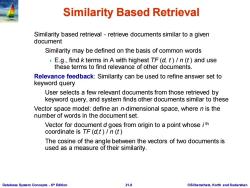
Similarity Based Retrieval Similarity based retrieval-retrieve documents similar to a given document Similarity may be defined on the basis of common words E.g.,find k terms in A with highest TF(d,t)/n(t)and use these terms to find relevance of other documents Relevance feedback:Similarity can be used to refine answer set to keyword query User selects a few relevant documents from those retrieved by keyword query,and system finds other documents similar to these Vector space model:define an n-dimensional space,where n is the number of words in the document set. Vector for document d goes from origin to a point whose ith coordinate is TF(d,t)/n(t) The cosine of the angle between the vectors of two documents is used as a measure of their similarity Database System Concepts-6th Edition 21.8 @Silberschatz,Korth and Sudarshan
Database System Concepts - 6 21.8 ©Silberschatz, Korth and Sudarshan th Edition Similarity Based Retrieval Similarity based retrieval - retrieve documents similar to a given document Similarity may be defined on the basis of common words E.g., find k terms in A with highest TF (d, t ) / n (t ) and use these terms to find relevance of other documents. Relevance feedback: Similarity can be used to refine answer set to keyword query User selects a few relevant documents from those retrieved by keyword query, and system finds other documents similar to these Vector space model: define an n-dimensional space, where n is the number of words in the document set. Vector for document d goes from origin to a point whose i th coordinate is TF (d,t ) / n (t ) The cosine of the angle between the vectors of two documents is used as a measure of their similarity
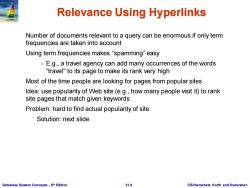
Relevance Using Hyperlinks Number of documents relevant to a query can be enormous if only term frequencies are taken into account Using term frequencies makes "spamming"easy E.g.,a travel agency can add many occurrences of the words "travel"to its page to make its rank very high Most of the time people are looking for pages from popular sites Idea:use popularity of Web site (e.g.,how many people visit it)to rank site pages that match given keywords Problem:hard to find actual popularity of site Solution:next slide Database System Concepts-6th Edition 21.9 @Silberschatz,Korth and Sudarshan
Database System Concepts - 6 21.9 ©Silberschatz, Korth and Sudarshan th Edition Relevance Using Hyperlinks Number of documents relevant to a query can be enormous if only term frequencies are taken into account Using term frequencies makes “spamming” easy E.g., a travel agency can add many occurrences of the words “travel” to its page to make its rank very high Most of the time people are looking for pages from popular sites Idea: use popularity of Web site (e.g., how many people visit it) to rank site pages that match given keywords Problem: hard to find actual popularity of site Solution: next slide
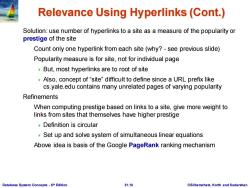
Relevance Using Hyperlinks(Cont.) Solution:use number of hyperlinks to a site as a measure of the popularity or prestige of the site Count only one hyperlink from each site(why?-see previous slide) Popularity measure is for site,not for individual page But,most hyperlinks are to root of site Also,concept of"site"difficult to define since a URL prefix like cs.yale.edu contains many unrelated pages of varying popularity Refinements When computing prestige based on links to a site,give more weight to links from sites that themselves have higher prestige Definition is circular Set up and solve system of simultaneous linear equations Above idea is basis of the Google PageRank ranking mechanism Database System Concepts-6th Edition 21.10 @Silberschatz,Korth and Sudarshan
Database System Concepts - 6 21.10 ©Silberschatz, Korth and Sudarshan th Edition Relevance Using Hyperlinks (Cont.) Solution: use number of hyperlinks to a site as a measure of the popularity or prestige of the site Count only one hyperlink from each site (why? - see previous slide) Popularity measure is for site, not for individual page But, most hyperlinks are to root of site Also, concept of “site” difficult to define since a URL prefix like cs.yale.edu contains many unrelated pages of varying popularity Refinements When computing prestige based on links to a site, give more weight to links from sites that themselves have higher prestige Definition is circular Set up and solve system of simultaneous linear equations Above idea is basis of the Google PageRank ranking mechanism

Relevance Using Hyperlinks(Cont.) Connections to social networking theories that ranked prestige of people E.g.,the president of the U.S.A has a high prestige since many people know him Someone known by multiple prestigious people has high prestige Hub and authority based ranking A hub is a page that stores links to many pages(on a topic) An authority is a page that contains actual information on a topic Each page gets a hub prestige based on prestige of authorities that it points to Each page gets an authority prestige based on prestige of hubs that point to it Again,prestige definitions are cyclic,and can be got by solving linear equations Use authority prestige when ranking answers to a query Database System Concepts-6th Edition 21.11 @Silberschatz,Korth and Sudarshan
Database System Concepts - 6 21.11 ©Silberschatz, Korth and Sudarshan th Edition Relevance Using Hyperlinks (Cont.) Connections to social networking theories that ranked prestige of people E.g., the president of the U.S.A has a high prestige since many people know him Someone known by multiple prestigious people has high prestige Hub and authority based ranking A hub is a page that stores links to many pages (on a topic) An authority is a page that contains actual information on a topic Each page gets a hub prestige based on prestige of authorities that it points to Each page gets an authority prestige based on prestige of hubs that point to it Again, prestige definitions are cyclic, and can be got by solving linear equations Use authority prestige when ranking answers to a query
按次数下载不扣除下载券;
注册用户24小时内重复下载只扣除一次;
顺序:VIP每日次数-->可用次数-->下载券;
- 《数据库系统概念 Database System Concepts》原书教学资源(第六版,PPT课件讲稿,英文版)Chapter 20 Data Analysis.ppt
- 《数据库系统概念 Database System Concepts》原书教学资源(第六版,PPT课件讲稿,英文版)Chapter 2 Introduction to the Relational Model.ppt
- 《数据库系统概念 Database System Concepts》原书教学资源(第六版,PPT课件讲稿,英文版)Chapter 19 Distributed Databases.ppt
- 《数据库系统概念 Database System Concepts》原书教学资源(第六版,PPT课件讲稿,英文版)Chapter 18 Parallel Databases.ppt
- 《数据库系统概念 Database System Concepts》原书教学资源(第六版,PPT课件讲稿,英文版)Chapter 17 Database System Architectures.ppt
- 《数据库系统概念 Database System Concepts》原书教学资源(第六版,PPT课件讲稿,英文版)Chapter 16 Recovery System.ppt
- 《数据库系统概念 Database System Concepts》原书教学资源(第六版,PPT课件讲稿,英文版)Chapter 15 Concurrency Control.ppt
- 《数据库系统概念 Database System Concepts》原书教学资源(第六版,PPT课件讲稿,英文版)Chapter 14 Transactions.ppt
- 《数据库系统概念 Database System Concepts》原书教学资源(第六版,PPT课件讲稿,英文版)Chapter 13 Query Optimization.ppt
- 《数据库系统概念 Database System Concepts》原书教学资源(第六版,PPT课件讲稿,英文版)Chapter 12 Query Processing.ppt
- 《数据库系统概念 Database System Concepts》原书教学资源(第六版,PPT课件讲稿,英文版)Chapter 11 Indexing and Hashing.ppt
- 《数据库系统概念 Database System Concepts》原书教学资源(第六版,PPT课件讲稿,英文版)Chapter 10 Storage and File Structure.ppt
- 《数据库系统概念 Database System Concepts》原书教学资源(第六版,PPT课件讲稿,英文版)Chapter 1 Introduction(Avi Silberschatz Henry F. Korth S. Sudarshan).ppt
- 电子科技大学:《大数据时代商业模式创新 Business model innovation》研究生课程教学资源(课件讲稿,杜义飞).pdf
- 电子科技大学:《大数据时代商业模式创新 Business model innovation》研究生课程教学资源(讲座)换一个视角看清商业本质.pdf
- 电子科技大学:《大数据时代商业模式创新 Business Model Innovation in the Times of Big Data》研究生课程教学资源(教学大纲,杜义飞).pdf
- 《物联网技术导论 Introduction of Internet of Things》课程教学资源(参考文献)群智感知计算(清华大学:在后台操纵的同时,用户对于污染、扭曲文字的识 刘云浩).pdf
- 南京大学:《物联网技术导论 Introduction of Internet of Things》课程教学资源(参考文献)基于位置服的务(架构与研究进展).pdf
- 南京大学:《物联网技术导论 Introduction of Internet of Things》课程教学资源(参考文献)Wi-Fi雷达 - 从RSSI到CSI.pdf
- 南京大学:《物联网技术导论 Introduction of Internet of Things》课程教学资源(参考文献)Survey of Wireless Indoor Positioning Techniques and Systems.pdf
- 《数据库系统概念 Database System Concepts》原书教学资源(第六版,PPT课件讲稿,英文版)Chapter 22 Object-Based Databases.ppt
- 《数据库系统概念 Database System Concepts》原书教学资源(第六版,PPT课件讲稿,英文版)Chapter 23 XML.ppt
- 《数据库系统概念 Database System Concepts》原书教学资源(第六版,PPT课件讲稿,英文版)Chapter 24 Advanced Application Development.ppt
- 《数据库系统概念 Database System Concepts》原书教学资源(第六版,PPT课件讲稿,英文版)Chapter 25 Advanced Data Types and New Applications.ppt
- 《数据库系统概念 Database System Concepts》原书教学资源(第六版,PPT课件讲稿,英文版)Chapter 26 Advanced Transaction Processing.ppt
- 《数据库系统概念 Database System Concepts》原书教学资源(第六版,PPT课件讲稿,英文版)Chapter 3 Introduction to SQL.ppt
- 《数据库系统概念 Database System Concepts》原书教学资源(第六版,PPT课件讲稿,英文版)Chapter 4 Intermediate SQL.ppt
- 《数据库系统概念 Database System Concepts》原书教学资源(第六版,PPT课件讲稿,英文版)Chapter 5 Advanced SQL.ppt
- 《数据库系统概念 Database System Concepts》原书教学资源(第六版,PPT课件讲稿,英文版)Chapter 6 Formal Relational Query Languages.ppt
- 《数据库系统概念 Database System Concepts》原书教学资源(第六版,PPT课件讲稿,英文版)Chapter 7 Database Design - The Entity-Relationship Approach.ppt
- 《数据库系统概念 Database System Concepts》原书教学资源(第六版,PPT课件讲稿,英文版)Chapter 8 Relational Database Design.ppt
- 《数据库系统概念 Database System Concepts》原书教学资源(第六版,PPT课件讲稿,英文版)Chapter 9 Application Design and Development.ppt
- 《数据库系统概念 Database System Concepts》原书教学资源(第六版,附录,英文版)Advanced Relational Database Design.pdf
- 《数据库系统概念 Database System Concepts》原书教学资源(第六版,附录,英文版)Other Relational Query Languages.pdf
- 《数据库系统概念 Database System Concepts》原书教学资源(第六版,附录,英文版)Network Model.pdf
- 《数据库系统概念 Database System Concepts》原书教学资源(第六版,附录,英文版)Hierarchical Model.pdf
- 《数据库系统概念 Database System Concepts》原书教学资源(第五版,附录,英文版)Chapter A Network Model.ppt
- 《数据库系统概念 Database System Concepts》原书教学资源(第五版,附录,英文版)Chapter B Hierarchical Model.ppt
- 《数据库系统概念 Database System Concepts》原书教学资源(第五版,附录,英文版)Appendix C Advanced Relational Database Design.ppt
- 《数据库系统概念 Database System Concepts》原书教学资源(第五版,PPT课件讲稿,英文版)Chapter 1 Introduction(Avi Silberschatz Henry F. Korth S. Sudarshan).ppt
